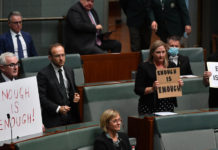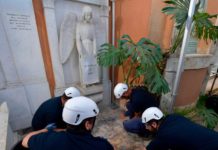The Australia Letter is a weekly newsletter from our Australia bureau. Sign up to get it by email.
When I first heard about Australia’s “bush courts,” I knew they were something I wanted to report on. Makeshift courtrooms, fly-in legal services, and Australians processed through that system who neither understood English nor how the courts worked. The details shocked me.
But as any journalist working in this country knows, stories about Indigenous Australia can be difficult: Communities can be extremely remote, may not speak English and can be distrustful of outsiders — with good reason. Gatekeepers can also be paternalistic, and especially skeptical of the media, in whom Australia’s trust has eroded.
But this should not stop us from trying. In fact, the more difficult access to a story is, the more it is often worth doing: Those shady corners are exactly the places journalists need to go.
So in mid-October, the photographer Matthew Abbott and I arranged permission to go to Wadeye, a remote community 250 miles from Darwin, which is among the largest Aboriginal communities in Australia and holds the country’s busiest bush court. From Darwin, we took the five-hour drive through the rocky Outback, where we would spend four days observing the courts, which processed dozens of cases a day.
In Wadeye, we met with three criminal lawyers from the North Australian Aboriginal Justice Agency, whose role it is to defend dozens of clients in a matter of days in a makeshift courtroom annexed to the police station. The night before the court sitting, they sat on the floor of the studio where they were staying, poring over files that spilled out of suitcases. A fan thwacked overhead.
Many clients had dozens of pages of criminal history, which was “not unusual,” said Holly Fitzsimmons, one of the lawyers. Most people, knowing they had charges, would turn up at the courthouse, she added. Others, who may not have cellphones or have received or been able to read their summons in English, would have to be found by driving through the town at dusk.
As night fell across the sweltering town — where stray dogs roamed the dusty streets and children cooled off in blowup swimming pools — a community liaison officer, who works with the legal team to identify clients, drove around looking for someone who was due at court the next day. She honked the horn of her four-wheel-drive outside a house she believed the woman was in, and waited.
“That’s how you find people in Wadeye,” said the officer, who asked that she not be named so as to protect her relationship with the community. “I don’t get out at night,” she added, “because of all the cheeky dogs.”
These are the kinds of moments you can witness only when you’re on the ground. But the difficulty of gaining access to some Indigenous communities, and a reluctance to let the media in, can make it challenging. In the courtroom, it can be even harder.
Though Australian courts work on a principle of open justice, there are some circumstances in which the judge can bar reporters from entering the courtroom or hearing certain information, as well as publishing it. Ostensibly, these rules are designed to protect defendants, but critics say that too often they protect the justice system from scrutiny.
Last year, the Northern Territory closed its youth courts, in what the government said was to prevent the “naming and shaming” of children in the media. But the press and critics said it was throwing a cover of darkness over an already problematic system, where judges have been investigated for making racist remarks, and Indigenous defendants often have unequal access to the same services as other Australians.
The laws also raise questions about the responsibility that falls on journalists themselves. It is our job to explain to those who distrust us why we are there, what we are doing, to report and write with integrity and sensitivity. I thought about this a lot in Wadeye.
I was also reminded that even when it feels uncomfortable, it is our job to stay put. It’s to push buttons that people with power don’t want pushed, and to ensure that people’s agency is respected: Anyone who wants to share a story should have the opportunity to do so.
I’m curious to hear your thoughts about how much access media should have to the courts, and to Indigenous communities.
Write to us at nytaustralia@nytimes.com.
Now, on to the week’s stories:
Source : Nytimes









-218x150.jpg)




